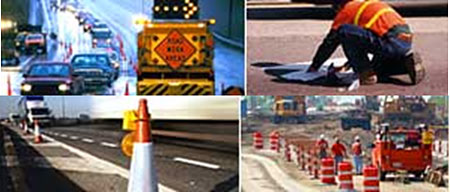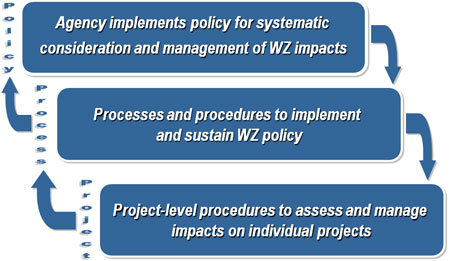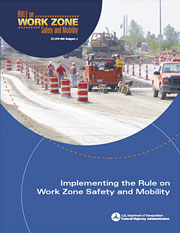Module 1: Work Zone Safety and Mobility Rule
Printable Version [PDF 7.22MB]
PDF files can be viewed with the Acrobat® Reader®.
Contact Information: WorkZoneFeedback@dot.gov
slide 1
Module 1: Work Zone Safety and Mobility Rule


narrator notes
This module discusses the Work Zone Safety and Mobility Rule, found in the Code of Federal Regulations at 23 CFR 630 Subpart J.
slide 2
About Module 1
- Overview
- Provisions
- Key Concepts Advocated
narrator notes
Module 1 provides a brief overview of the Rule, followed by information on the key provisions and concepts advocated by the Rule.
slide 3
Rule Overview

- Updates and renames 23 CFR 630 Subpart J
- Key dates
- September 9, 2004 – Rule Published
- October 12, 2007 – Rule Effective
- Applies to all Agencies that receive Federal-aid highway funding
narrator notes
The Work Zone Safety and Mobility Rule updates and renames the former regulation on "Traffic Safety in Highway and Street Work Zones," found in 23 CFR 630 Subpart J.
The revised Rule was published in 2004. Transportation Agencies were given just over 3 years, until October 12, 2007, to update their existing practices and policies to comply with the requirements of the revised Rule.
The Rule applies specifically to all Federal-aid highway projects. Agencies are encouraged to apply the good practices that the Rule fosters to other road projects as well, and many DOTs have chosen to do so.
slide 4
Rule Overview

- Establishes requirements and provides guidance for:
- Addressing work zone safety and mobility impacts
- Developing strategies to manage those impacts
- More comprehensive approach
narrator notes
The updated Rule not only emphasizes the importance of safety, but also adds a focus on providing for mobility in and around work zones. It provides for the systematic consideration of work zone impacts during project development. And it provides for the development of an appropriate Transportation Management Plan that contains strategies to help manage those impacts during road work.
The updated Rule fosters a more comprehensive approach to work zone planning, implementation, and management.
slide 5
Rule Provisions

narrator notes
The updated Rule advocates a systematic approach for managing work zone safety and mobility, and has 3 primary components:
- Agency Work zone safety and mobility policy,
- Agency-level processes and procedures, and
- Project-level procedures to address work zone impacts.
For each component, the Rule includes provisions and guidance to help transportation Agencies address work zone considerations, starting early in planning and progressing through design, construction, and post-construction.
The Policy an Agency develops and implements will guide and influence its standard processes and procedures, which in turn will also guide what the Agency does at the project level. In turn, as the DOT sees how certain project-level efforts work in the field, it can use that information over time to refine its work zone policy and higher level processes and procedures.
slide 6
Rule Provisions
- Develop & implement a work zone policy
- Develop & implement Agency-level procedures:
- Work zone impact assessment & management
- Training
- Use of safety & operational data
- Process reviews
narrator notes
The Policy imparts the Agency's vision and approach to work zone management and indicates support from Agency leadership. This provision was intended to help Agencies update and enhance their existing policies to meet the intent of the Rule, or create a new policy if needed.
Institutionalizing Agency processes and procedures will help to streamline and standardize work zone practices that support decision-making throughout the project life cycle.
While the Rule encourages Agencies to develop and implement procedures to assess and mitigate work zone impacts, it requires Agency processes and procedures for work zone related training, use of work zone data, and process reviews.
The Rule requires Agencies to provide periodic training for personnel involved in work zone related transportation management and traffic control.
The Rule also requires Agencies to use work zone safety and operational data to manage and improve work zone safety and mobility. This data requirement applies to both current projects in the field, as well as future projects.
In addition, Agencies are required to assess the effectiveness of their work zone safety and mobility procedures at least every two years by performing a process review.
slide 7
Rule Provisions
- Develop & Implement Project Procedures:
- Identify significant projects
- Develop Transportation Management Plans (TMPs)
- Include appropriate pay item provisions for implementing the TMP in the PS&Es
- Assign a "responsible person" to implement and monitor TMP elements at the project-level
- Who is appropriately trained
- Who has primary responsibility and sufficient authority
- For implementing the TMP
- Other safety and mobility project aspects
narrator notes
Agencies are now required to identify future projects with potential for a higher level of disruption. These projects are called, "significant projects." This disruption is also referred to as work zone impacts. The Agency develops mitigation measures to manage those impacts. The TMP is the vehicle through which this information is documented and implemented.
The project's Plans, Specifications, and Estimates, or PS&Es, are required to contain provisions for implementing the applicable elements of a TMP. The TMP is often developed by an Agency before a project goes to bid. However, for some projects the Agency may have the Contractor develop the TMP through the contract. In this case, the Agency would include the TMP development requirement in the PS&Es along with general guidelines for the TMP.
The Rule requires that, the Agency and the Contractor, each designate a trained person at the project-level who has the primary responsibility and sufficient authority for implementing the TMP. The designated personnel must be appropriately trained.
slide 8
Key Concepts Advocated by the Rule
- Better understand, anticipate, and plan for work zone impacts:
- Assess/understand local as well as corridor and network impacts
- Examine solutions that minimize these impacts
- Involve stakeholders in the process
- Facilitate customer-focused project development
- Begin early in program delivery
narrator notes
The updated Rule advocates a few key concepts to help Agencies be effective in reducing the safety and mobility impacts from work zones.
First, the Rule encourages DOTs to actively assess and plan for work zone impacts. This involves looking beyond the immediate location of the work zone to consider the surrounding corridor and the transportation network, and how residents, businesses, commuters, and other stakeholders will be impacted. Once the anticipated impacts are understood, DOTs can examine solutions to reduce and manage those impacts.
These efforts need to begin early in program delivery, so that these considerations can be addressed in budgeting, scheduling, and design.
slide 9
Key Concepts Advocated by the Rule
- Consider solutions that go beyond the immediate location of the work zone:
- Expand work zone management beyond traffic safety and control
- Managing a transportation system
- Address safety and mobility
- Integrate this holistic thinking into the DOT culture
narrator notes
If we view our task as having a transportation system to manage, rather than building a road and guiding traffic through the work zone, many more options become apparent. Options such as the use of alternate routes, transit service enhancements, signal timing adjustments, and travel demand management.
The Rule fosters a new way of thinking as State DOTs consider these safety and mobility impacts from scoping through construction.
slide 10
For More Information on the Rule
FHWA has several resources available:
- Implementing the Rule on Work Zone Safety and Mobility (23 CFR 630 Subpart J)
- Developing and Implementing TMPs for Work Zones

To access these and other references, visit: http://www.ops.fhwa.dot.gov/wz/resources/final_rule.htm.
narrator notes
Please visit the website listed on the slide to access FHWA resources and for more information on Rule implementation.
previous | next